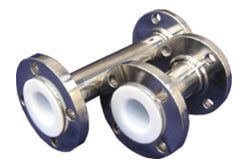Understanding SS 304 PTFE Lined Pipes


In industrial applications, the importance of using the right type of pipes cannot be overstated. Choosing the wrong material can lead to contamination, corrosion, and other issues that can compromise the efficiency and safety of your processes. Today, we’ll be discussing one particular type of pipe – SS 304 PTFE Lined Pipes. In this blog post, we’ll explore what these pipes are, how they work, and what benefits they offer. So, whether you’re a business owner or a technical professional, read on to learn more about these pipes.
What are Stainless Steel 304 PTFE lined pipes?
These pipes are made of two main components – a stainless-steel pipe and a PTFE liner. The pipe itself is made of high-quality stainless steel, which is strong, durable, and resistant to corrosion. The PTFE liner, on the other hand, is made of a synthetic fluoropolymer that offers excellent chemical resistance and low friction.
How do they work?
The PTFE liner inside these pipes creates a barrier between the fluid being transported and the stainless-steel pipe. This prevents the fluid from coming into contact with the metal, which can cause corrosion and contamination. The PTFE liner also offers excellent chemical resistance, which makes these pipes ideal for applications where aggressive or acidic substances are being transported.
What benefits do Stainless Steel 304 PTFE lined pipes offer?
a. Corrosion resistance: these pipes are highly resistant to corrosion, which means they have a long lifespan and require minimal maintenance.
b. Chemical resistance: PTFE is highly resistant to a wide range of chemicals, making these pipes ideal for transporting aggressive or acidic substances.
c. Low friction: The smooth surface of the PTFE liner inside these pipes creates a low-friction environment, which improves flow rates and reduces energy consumption.
d. Easy to clean: The non-stick surface of PTFE makes it easy to clean and maintain, which is essential in applications where hygiene is paramount.
e. Wide temperature range: these pipes can withstand a wide range of temperatures, from -20°C to 150°C, making them suitable for use in both hot and cold applications.
Where are Stainless Steel 304 PTFE lined pipes commonly used?
These pipes are commonly used in industries such as chemical processing, pharmaceuticals, food and beverage, and water treatment. They’re also used in applications where the transport of aggressive or corrosive fluids is necessary.
Chemical Properties:
SS 304 PTFE Lined Pipes have outstanding chemical resistance properties, making them ideal for handling corrosive chemicals. The PTFE coating provides a nonreactive and non-contaminant surface necessary for some harsh chemical applications. Additionally, the SS 304 material is durable and resistant to corrosion cracking and pitting, making it a cost-effective option for chemical processing applications.
High-Temperature Resistance:
The PTFE lining coating on SS 304 PTFE Lined Pipes allows them to withstand a wide temperature range from -20 to 260 degrees Celsius. This makes them ideal for handling high-temperature fluids, steam, and corrosive chemicals. Moreover, due to its low thermal conductivity, it is an excellent insulating material.
Excellent Electrical Properties:
PTFE is a remarkable electrical insulator that prevents electrical current from escaping the pipes. It also has excellent dielectric strength and low dissipation factor, making it ideal for electronic and electrical applications. These Pipes have these properties, which enable them to convey currents, especially in the semiconductor industry.
Easy to Clean and Maintain:
SS 304 PTFE Lined Pipes have a smooth surface that prevents buildup of dirt and other impurities. The PTFE lining is non-stick and prevents limescale and debris from accumulating in the pipes. This makes them easy to clean and maintain, reducing downtime and saving on cleaning chemicals.
Cost-Effective:
SS 304 PTFE Lined Pipes are a cost-effective solution to your processing needs. The stainless steel material is durable and cost-effective, while the PTFE lining provides superior chemical resistance and temperature stability, reducing maintenance and replacement costs.



